Challenges of Teamwork and Building Effective Teams: A Detailed Report
VerifiedAdded on 2023/06/10
|8
|2259
|74
Report
AI Summary
This report delves into the multifaceted challenges of team building and teamwork within organizations. It begins by defining teamwork and highlighting its importance in achieving organizational goals, referencing various academic sources. The report identifies common challenges such as unclear team objectives, conflicts among team members, ineffective communication, lack of trust, and insufficient assessment of team performance. It explores the impact of these challenges on team dynamics and overall organizational success. The report also discusses the role of team leaders in addressing these issues, emphasizing the need for strong leadership, open communication, and conflict resolution. Furthermore, the report examines the influence of factors like cross-cultural communication and remote team dynamics on team performance. The conclusion emphasizes the importance of proactively addressing teamwork challenges to foster effective collaboration and achieve organizational objectives, advocating for strategies that promote clear vision, strong values, and continuous improvement.
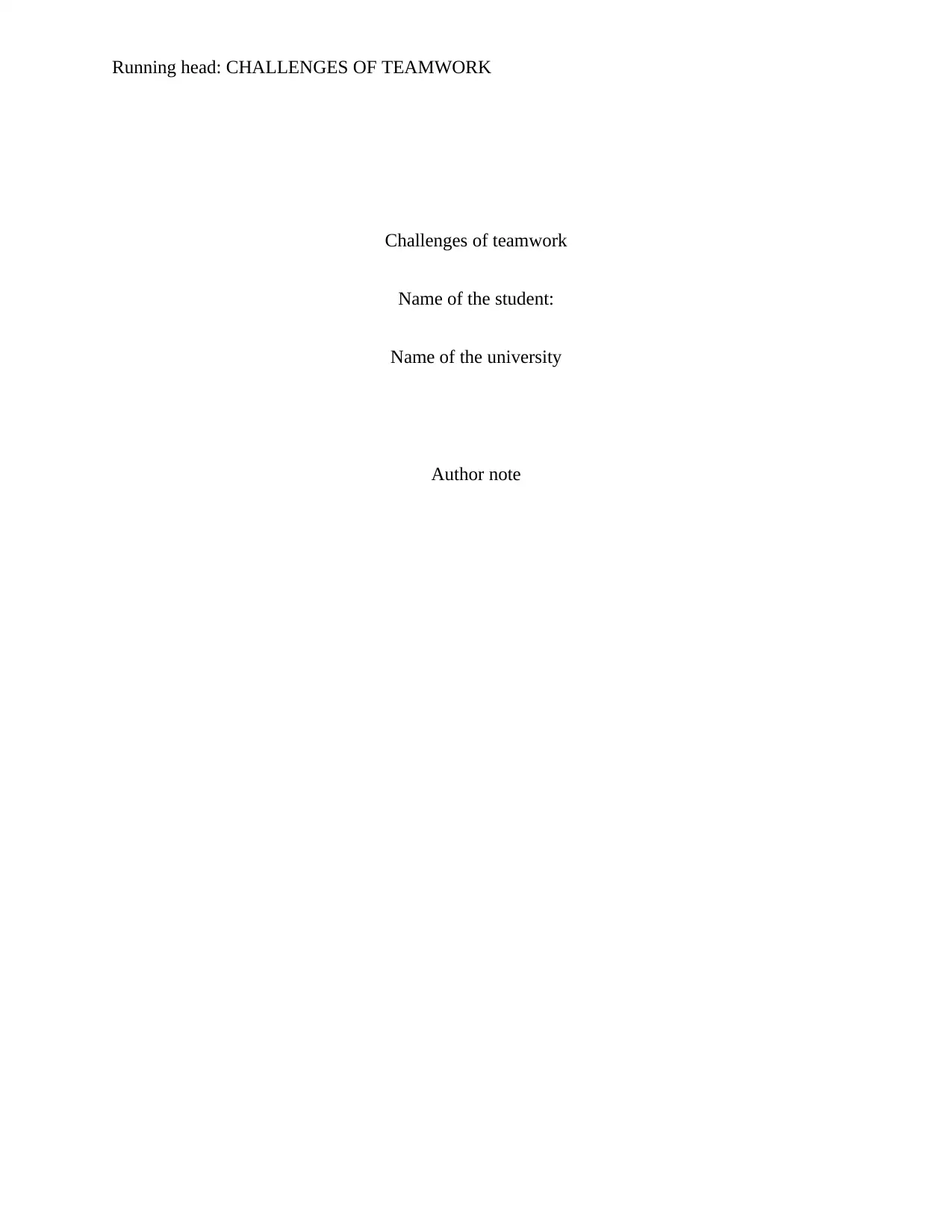
Running head: CHALLENGES OF TEAMWORK
Challenges of teamwork
Name of the student:
Name of the university
Author note
Challenges of teamwork
Name of the student:
Name of the university
Author note
Paraphrase This Document
Need a fresh take? Get an instant paraphrase of this document with our AI Paraphraser
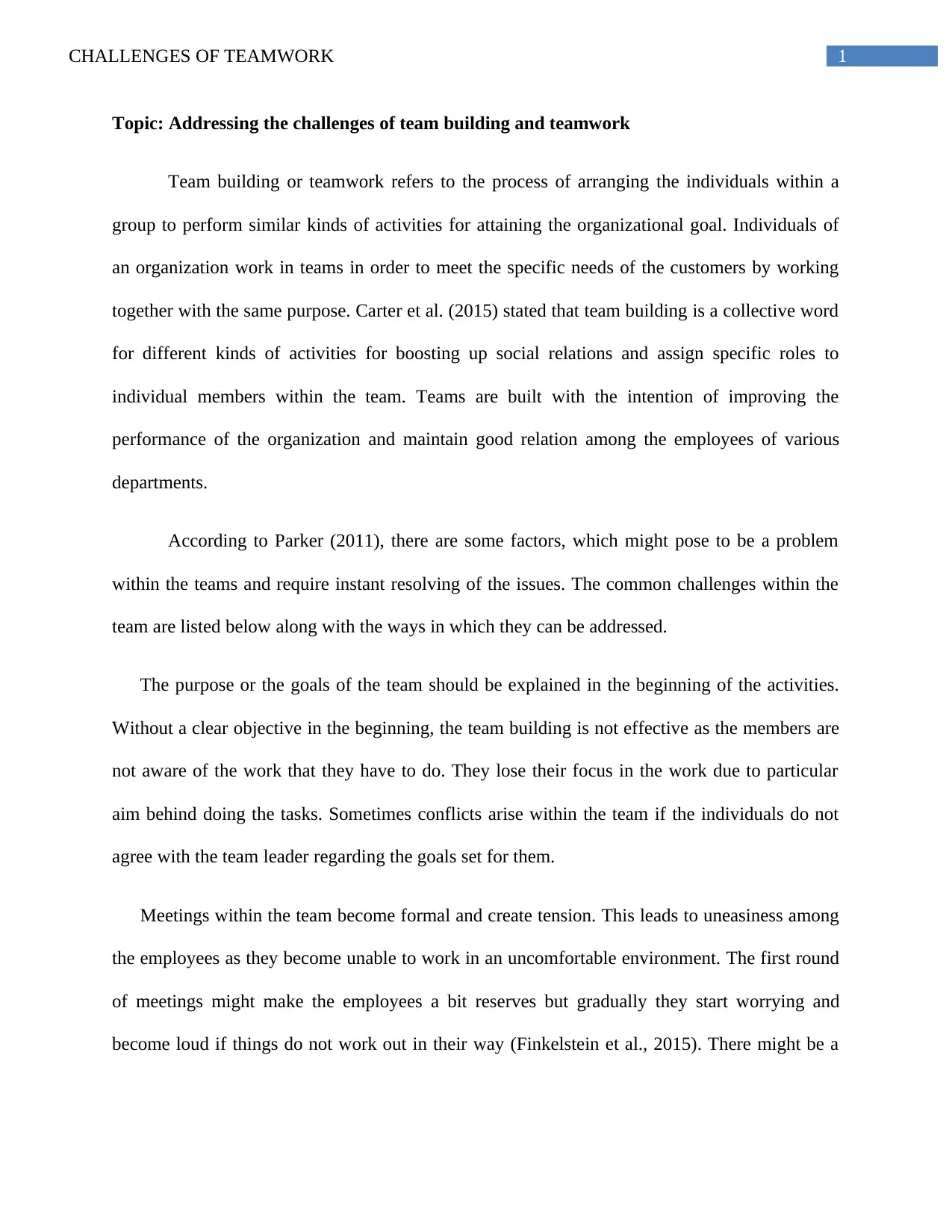
1CHALLENGES OF TEAMWORK
Topic: Addressing the challenges of team building and teamwork
Team building or teamwork refers to the process of arranging the individuals within a
group to perform similar kinds of activities for attaining the organizational goal. Individuals of
an organization work in teams in order to meet the specific needs of the customers by working
together with the same purpose. Carter et al. (2015) stated that team building is a collective word
for different kinds of activities for boosting up social relations and assign specific roles to
individual members within the team. Teams are built with the intention of improving the
performance of the organization and maintain good relation among the employees of various
departments.
According to Parker (2011), there are some factors, which might pose to be a problem
within the teams and require instant resolving of the issues. The common challenges within the
team are listed below along with the ways in which they can be addressed.
The purpose or the goals of the team should be explained in the beginning of the activities.
Without a clear objective in the beginning, the team building is not effective as the members are
not aware of the work that they have to do. They lose their focus in the work due to particular
aim behind doing the tasks. Sometimes conflicts arise within the team if the individuals do not
agree with the team leader regarding the goals set for them.
Meetings within the team become formal and create tension. This leads to uneasiness among
the employees as they become unable to work in an uncomfortable environment. The first round
of meetings might make the employees a bit reserves but gradually they start worrying and
become loud if things do not work out in their way (Finkelstein et al., 2015). There might be a
Topic: Addressing the challenges of team building and teamwork
Team building or teamwork refers to the process of arranging the individuals within a
group to perform similar kinds of activities for attaining the organizational goal. Individuals of
an organization work in teams in order to meet the specific needs of the customers by working
together with the same purpose. Carter et al. (2015) stated that team building is a collective word
for different kinds of activities for boosting up social relations and assign specific roles to
individual members within the team. Teams are built with the intention of improving the
performance of the organization and maintain good relation among the employees of various
departments.
According to Parker (2011), there are some factors, which might pose to be a problem
within the teams and require instant resolving of the issues. The common challenges within the
team are listed below along with the ways in which they can be addressed.
The purpose or the goals of the team should be explained in the beginning of the activities.
Without a clear objective in the beginning, the team building is not effective as the members are
not aware of the work that they have to do. They lose their focus in the work due to particular
aim behind doing the tasks. Sometimes conflicts arise within the team if the individuals do not
agree with the team leader regarding the goals set for them.
Meetings within the team become formal and create tension. This leads to uneasiness among
the employees as they become unable to work in an uncomfortable environment. The first round
of meetings might make the employees a bit reserves but gradually they start worrying and
become loud if things do not work out in their way (Finkelstein et al., 2015). There might be a
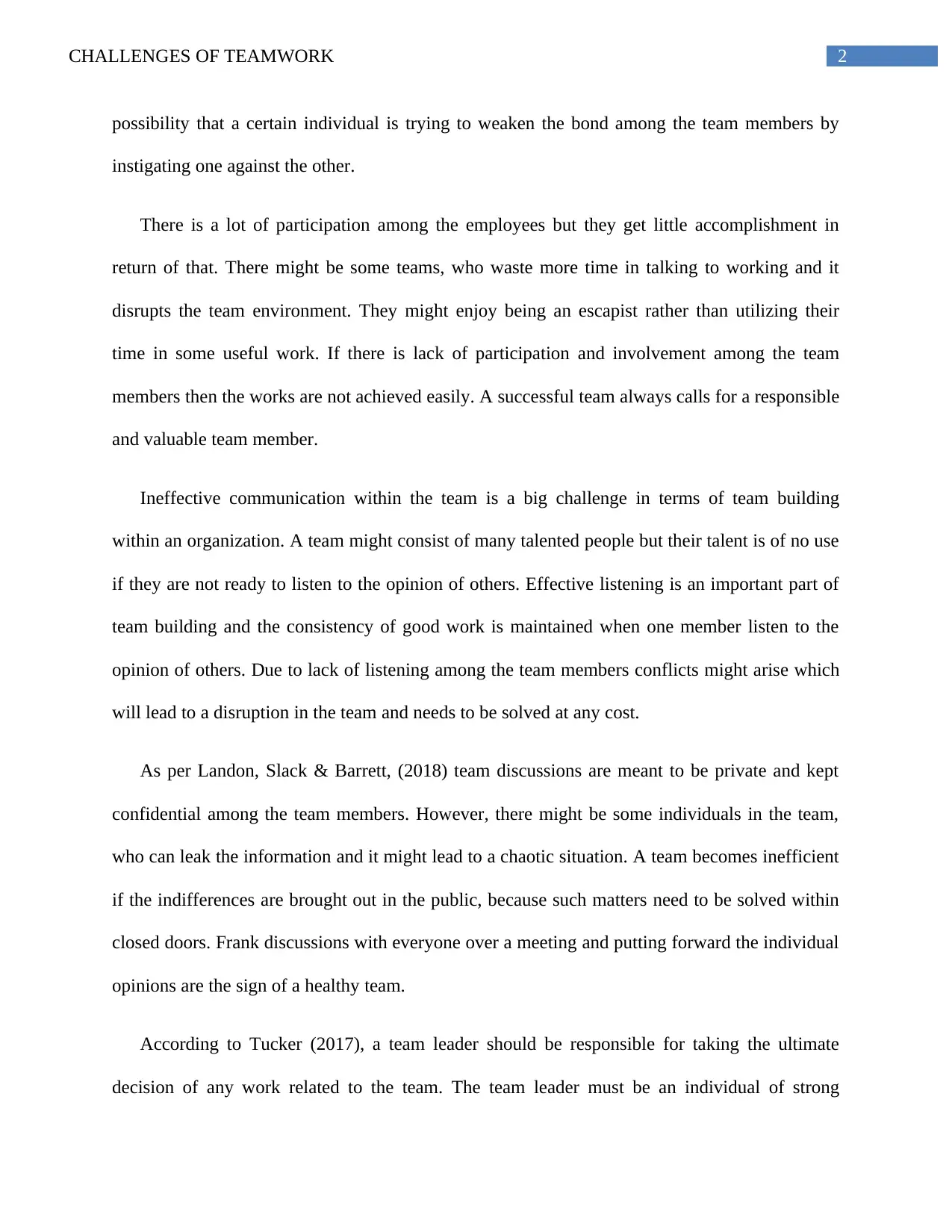
2CHALLENGES OF TEAMWORK
possibility that a certain individual is trying to weaken the bond among the team members by
instigating one against the other.
There is a lot of participation among the employees but they get little accomplishment in
return of that. There might be some teams, who waste more time in talking to working and it
disrupts the team environment. They might enjoy being an escapist rather than utilizing their
time in some useful work. If there is lack of participation and involvement among the team
members then the works are not achieved easily. A successful team always calls for a responsible
and valuable team member.
Ineffective communication within the team is a big challenge in terms of team building
within an organization. A team might consist of many talented people but their talent is of no use
if they are not ready to listen to the opinion of others. Effective listening is an important part of
team building and the consistency of good work is maintained when one member listen to the
opinion of others. Due to lack of listening among the team members conflicts might arise which
will lead to a disruption in the team and needs to be solved at any cost.
As per Landon, Slack & Barrett, (2018) team discussions are meant to be private and kept
confidential among the team members. However, there might be some individuals in the team,
who can leak the information and it might lead to a chaotic situation. A team becomes inefficient
if the indifferences are brought out in the public, because such matters need to be solved within
closed doors. Frank discussions with everyone over a meeting and putting forward the individual
opinions are the sign of a healthy team.
According to Tucker (2017), a team leader should be responsible for taking the ultimate
decision of any work related to the team. The team leader must be an individual of strong
possibility that a certain individual is trying to weaken the bond among the team members by
instigating one against the other.
There is a lot of participation among the employees but they get little accomplishment in
return of that. There might be some teams, who waste more time in talking to working and it
disrupts the team environment. They might enjoy being an escapist rather than utilizing their
time in some useful work. If there is lack of participation and involvement among the team
members then the works are not achieved easily. A successful team always calls for a responsible
and valuable team member.
Ineffective communication within the team is a big challenge in terms of team building
within an organization. A team might consist of many talented people but their talent is of no use
if they are not ready to listen to the opinion of others. Effective listening is an important part of
team building and the consistency of good work is maintained when one member listen to the
opinion of others. Due to lack of listening among the team members conflicts might arise which
will lead to a disruption in the team and needs to be solved at any cost.
As per Landon, Slack & Barrett, (2018) team discussions are meant to be private and kept
confidential among the team members. However, there might be some individuals in the team,
who can leak the information and it might lead to a chaotic situation. A team becomes inefficient
if the indifferences are brought out in the public, because such matters need to be solved within
closed doors. Frank discussions with everyone over a meeting and putting forward the individual
opinions are the sign of a healthy team.
According to Tucker (2017), a team leader should be responsible for taking the ultimate
decision of any work related to the team. The team leader must be an individual of strong
⊘ This is a preview!⊘
Do you want full access?
Subscribe today to unlock all pages.

Trusted by 1+ million students worldwide
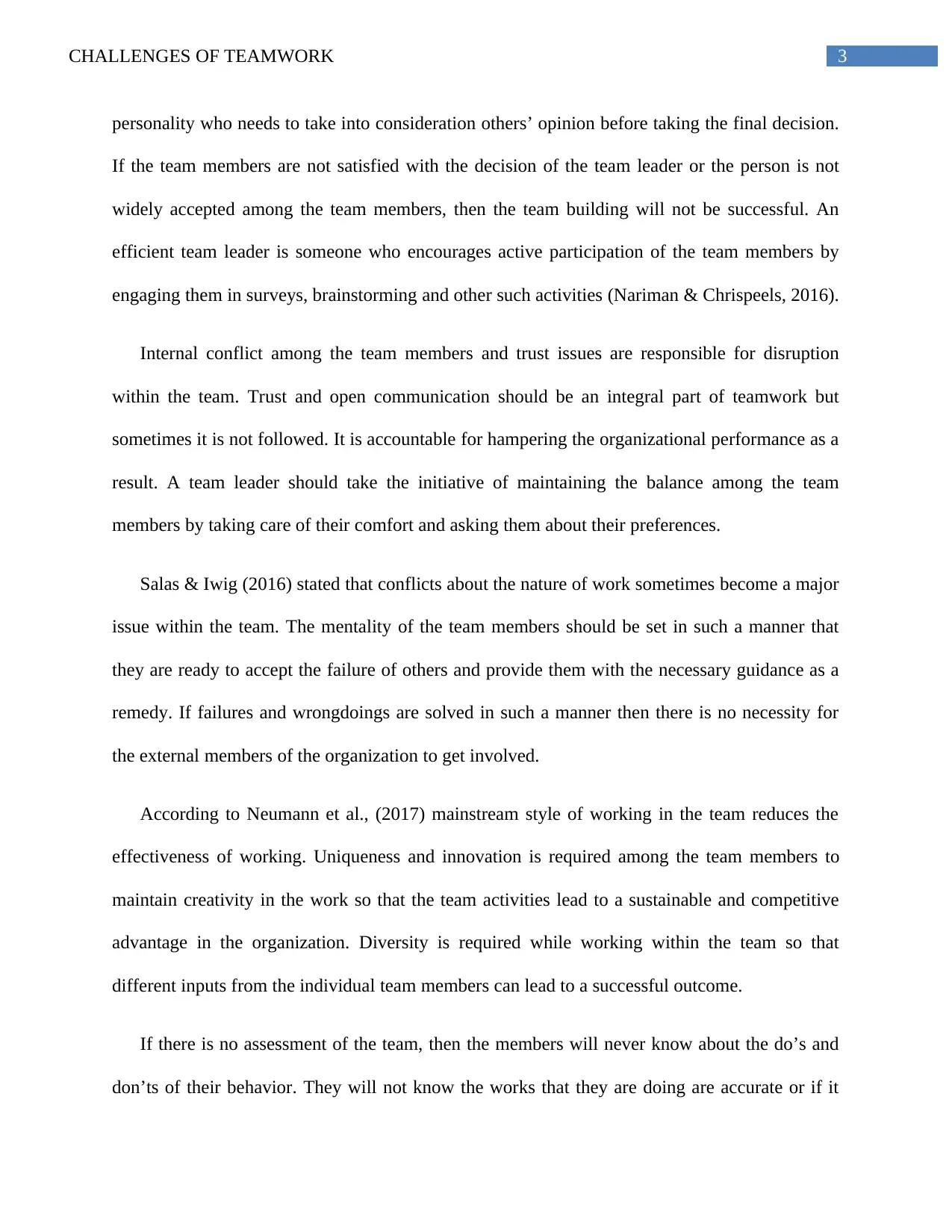
3CHALLENGES OF TEAMWORK
personality who needs to take into consideration others’ opinion before taking the final decision.
If the team members are not satisfied with the decision of the team leader or the person is not
widely accepted among the team members, then the team building will not be successful. An
efficient team leader is someone who encourages active participation of the team members by
engaging them in surveys, brainstorming and other such activities (Nariman & Chrispeels, 2016).
Internal conflict among the team members and trust issues are responsible for disruption
within the team. Trust and open communication should be an integral part of teamwork but
sometimes it is not followed. It is accountable for hampering the organizational performance as a
result. A team leader should take the initiative of maintaining the balance among the team
members by taking care of their comfort and asking them about their preferences.
Salas & Iwig (2016) stated that conflicts about the nature of work sometimes become a major
issue within the team. The mentality of the team members should be set in such a manner that
they are ready to accept the failure of others and provide them with the necessary guidance as a
remedy. If failures and wrongdoings are solved in such a manner then there is no necessity for
the external members of the organization to get involved.
According to Neumann et al., (2017) mainstream style of working in the team reduces the
effectiveness of working. Uniqueness and innovation is required among the team members to
maintain creativity in the work so that the team activities lead to a sustainable and competitive
advantage in the organization. Diversity is required while working within the team so that
different inputs from the individual team members can lead to a successful outcome.
If there is no assessment of the team, then the members will never know about the do’s and
don’ts of their behavior. They will not know the works that they are doing are accurate or if it
personality who needs to take into consideration others’ opinion before taking the final decision.
If the team members are not satisfied with the decision of the team leader or the person is not
widely accepted among the team members, then the team building will not be successful. An
efficient team leader is someone who encourages active participation of the team members by
engaging them in surveys, brainstorming and other such activities (Nariman & Chrispeels, 2016).
Internal conflict among the team members and trust issues are responsible for disruption
within the team. Trust and open communication should be an integral part of teamwork but
sometimes it is not followed. It is accountable for hampering the organizational performance as a
result. A team leader should take the initiative of maintaining the balance among the team
members by taking care of their comfort and asking them about their preferences.
Salas & Iwig (2016) stated that conflicts about the nature of work sometimes become a major
issue within the team. The mentality of the team members should be set in such a manner that
they are ready to accept the failure of others and provide them with the necessary guidance as a
remedy. If failures and wrongdoings are solved in such a manner then there is no necessity for
the external members of the organization to get involved.
According to Neumann et al., (2017) mainstream style of working in the team reduces the
effectiveness of working. Uniqueness and innovation is required among the team members to
maintain creativity in the work so that the team activities lead to a sustainable and competitive
advantage in the organization. Diversity is required while working within the team so that
different inputs from the individual team members can lead to a successful outcome.
If there is no assessment of the team, then the members will never know about the do’s and
don’ts of their behavior. They will not know the works that they are doing are accurate or if it
Paraphrase This Document
Need a fresh take? Get an instant paraphrase of this document with our AI Paraphraser
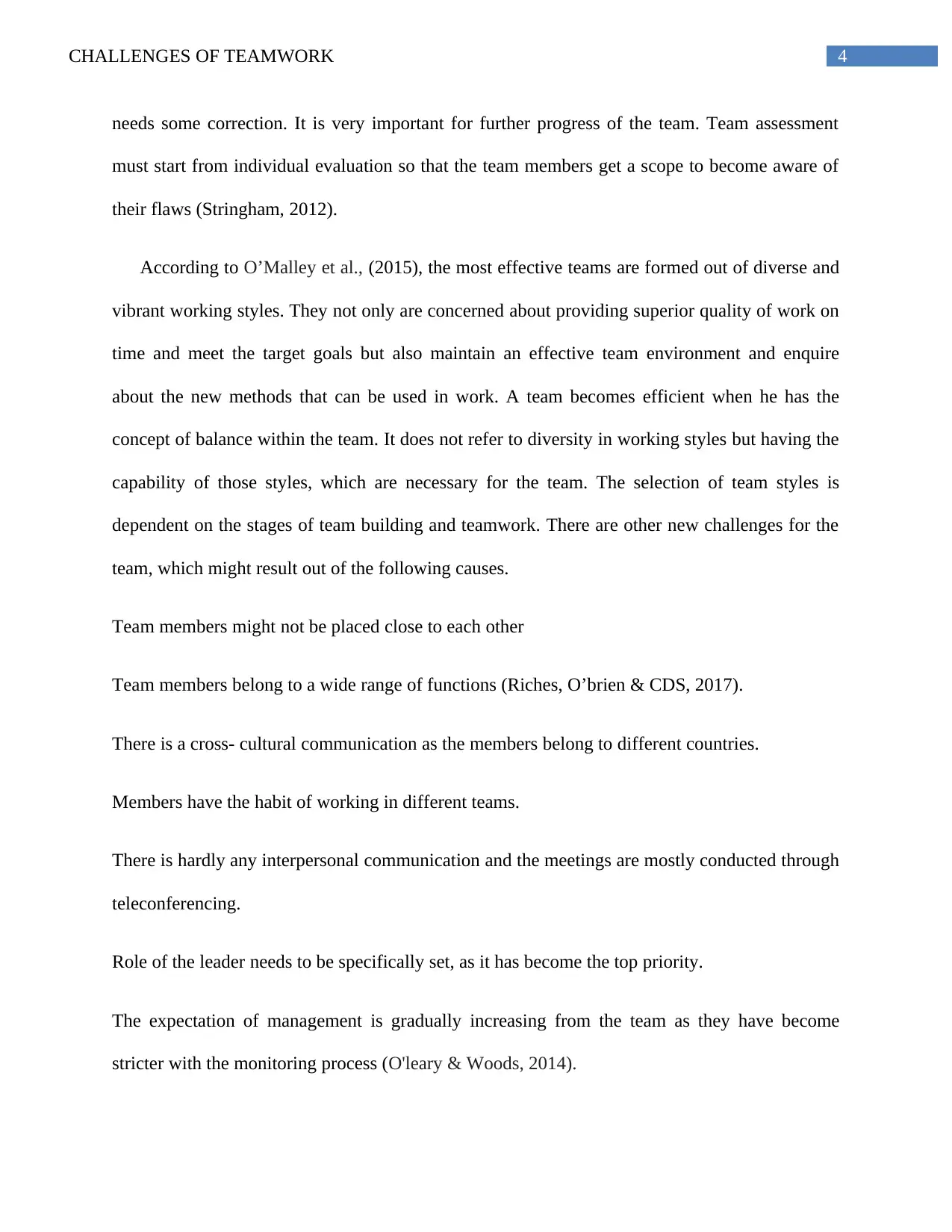
4CHALLENGES OF TEAMWORK
needs some correction. It is very important for further progress of the team. Team assessment
must start from individual evaluation so that the team members get a scope to become aware of
their flaws (Stringham, 2012).
According to O’Malley et al., (2015), the most effective teams are formed out of diverse and
vibrant working styles. They not only are concerned about providing superior quality of work on
time and meet the target goals but also maintain an effective team environment and enquire
about the new methods that can be used in work. A team becomes efficient when he has the
concept of balance within the team. It does not refer to diversity in working styles but having the
capability of those styles, which are necessary for the team. The selection of team styles is
dependent on the stages of team building and teamwork. There are other new challenges for the
team, which might result out of the following causes.
Team members might not be placed close to each other
Team members belong to a wide range of functions (Riches, O’brien & CDS, 2017).
There is a cross- cultural communication as the members belong to different countries.
Members have the habit of working in different teams.
There is hardly any interpersonal communication and the meetings are mostly conducted through
teleconferencing.
Role of the leader needs to be specifically set, as it has become the top priority.
The expectation of management is gradually increasing from the team as they have become
stricter with the monitoring process (O'leary & Woods, 2014).
needs some correction. It is very important for further progress of the team. Team assessment
must start from individual evaluation so that the team members get a scope to become aware of
their flaws (Stringham, 2012).
According to O’Malley et al., (2015), the most effective teams are formed out of diverse and
vibrant working styles. They not only are concerned about providing superior quality of work on
time and meet the target goals but also maintain an effective team environment and enquire
about the new methods that can be used in work. A team becomes efficient when he has the
concept of balance within the team. It does not refer to diversity in working styles but having the
capability of those styles, which are necessary for the team. The selection of team styles is
dependent on the stages of team building and teamwork. There are other new challenges for the
team, which might result out of the following causes.
Team members might not be placed close to each other
Team members belong to a wide range of functions (Riches, O’brien & CDS, 2017).
There is a cross- cultural communication as the members belong to different countries.
Members have the habit of working in different teams.
There is hardly any interpersonal communication and the meetings are mostly conducted through
teleconferencing.
Role of the leader needs to be specifically set, as it has become the top priority.
The expectation of management is gradually increasing from the team as they have become
stricter with the monitoring process (O'leary & Woods, 2014).
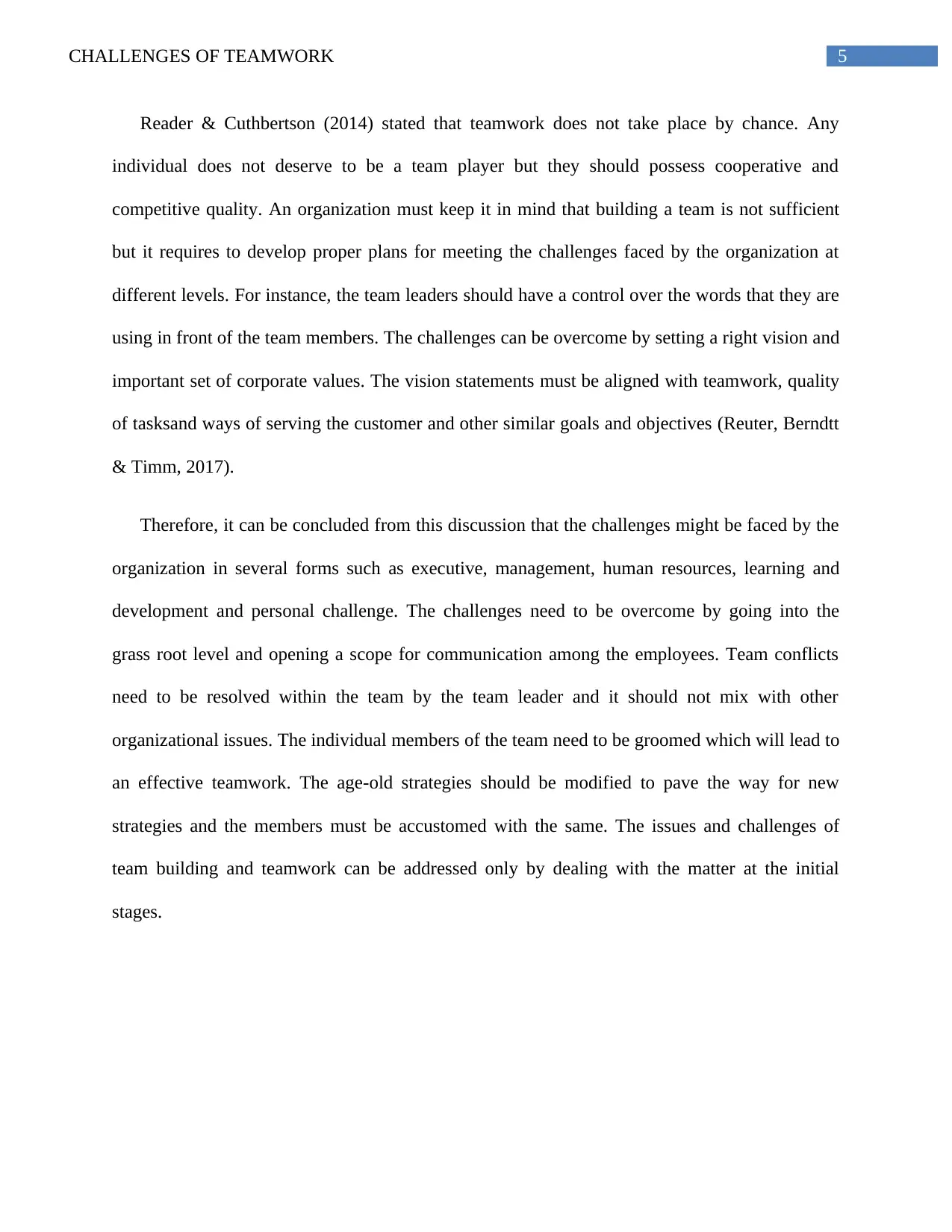
5CHALLENGES OF TEAMWORK
Reader & Cuthbertson (2014) stated that teamwork does not take place by chance. Any
individual does not deserve to be a team player but they should possess cooperative and
competitive quality. An organization must keep it in mind that building a team is not sufficient
but it requires to develop proper plans for meeting the challenges faced by the organization at
different levels. For instance, the team leaders should have a control over the words that they are
using in front of the team members. The challenges can be overcome by setting a right vision and
important set of corporate values. The vision statements must be aligned with teamwork, quality
of tasksand ways of serving the customer and other similar goals and objectives (Reuter, Berndtt
& Timm, 2017).
Therefore, it can be concluded from this discussion that the challenges might be faced by the
organization in several forms such as executive, management, human resources, learning and
development and personal challenge. The challenges need to be overcome by going into the
grass root level and opening a scope for communication among the employees. Team conflicts
need to be resolved within the team by the team leader and it should not mix with other
organizational issues. The individual members of the team need to be groomed which will lead to
an effective teamwork. The age-old strategies should be modified to pave the way for new
strategies and the members must be accustomed with the same. The issues and challenges of
team building and teamwork can be addressed only by dealing with the matter at the initial
stages.
Reader & Cuthbertson (2014) stated that teamwork does not take place by chance. Any
individual does not deserve to be a team player but they should possess cooperative and
competitive quality. An organization must keep it in mind that building a team is not sufficient
but it requires to develop proper plans for meeting the challenges faced by the organization at
different levels. For instance, the team leaders should have a control over the words that they are
using in front of the team members. The challenges can be overcome by setting a right vision and
important set of corporate values. The vision statements must be aligned with teamwork, quality
of tasksand ways of serving the customer and other similar goals and objectives (Reuter, Berndtt
& Timm, 2017).
Therefore, it can be concluded from this discussion that the challenges might be faced by the
organization in several forms such as executive, management, human resources, learning and
development and personal challenge. The challenges need to be overcome by going into the
grass root level and opening a scope for communication among the employees. Team conflicts
need to be resolved within the team by the team leader and it should not mix with other
organizational issues. The individual members of the team need to be groomed which will lead to
an effective teamwork. The age-old strategies should be modified to pave the way for new
strategies and the members must be accustomed with the same. The issues and challenges of
team building and teamwork can be addressed only by dealing with the matter at the initial
stages.
⊘ This is a preview!⊘
Do you want full access?
Subscribe today to unlock all pages.

Trusted by 1+ million students worldwide
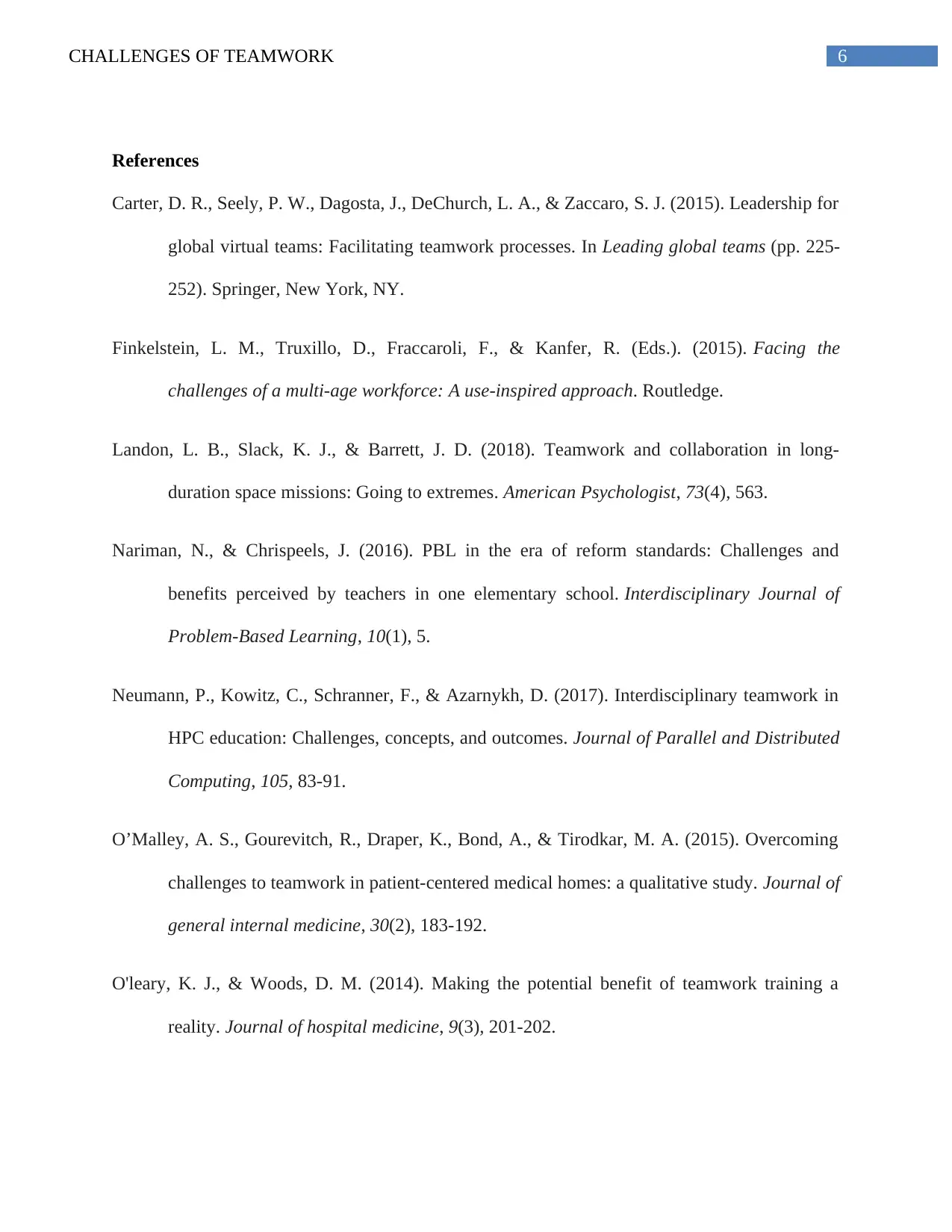
6CHALLENGES OF TEAMWORK
References
Carter, D. R., Seely, P. W., Dagosta, J., DeChurch, L. A., & Zaccaro, S. J. (2015). Leadership for
global virtual teams: Facilitating teamwork processes. In Leading global teams (pp. 225-
252). Springer, New York, NY.
Finkelstein, L. M., Truxillo, D., Fraccaroli, F., & Kanfer, R. (Eds.). (2015). Facing the
challenges of a multi-age workforce: A use-inspired approach. Routledge.
Landon, L. B., Slack, K. J., & Barrett, J. D. (2018). Teamwork and collaboration in long-
duration space missions: Going to extremes. American Psychologist, 73(4), 563.
Nariman, N., & Chrispeels, J. (2016). PBL in the era of reform standards: Challenges and
benefits perceived by teachers in one elementary school. Interdisciplinary Journal of
Problem-Based Learning, 10(1), 5.
Neumann, P., Kowitz, C., Schranner, F., & Azarnykh, D. (2017). Interdisciplinary teamwork in
HPC education: Challenges, concepts, and outcomes. Journal of Parallel and Distributed
Computing, 105, 83-91.
O’Malley, A. S., Gourevitch, R., Draper, K., Bond, A., & Tirodkar, M. A. (2015). Overcoming
challenges to teamwork in patient-centered medical homes: a qualitative study. Journal of
general internal medicine, 30(2), 183-192.
O'leary, K. J., & Woods, D. M. (2014). Making the potential benefit of teamwork training a
reality. Journal of hospital medicine, 9(3), 201-202.
References
Carter, D. R., Seely, P. W., Dagosta, J., DeChurch, L. A., & Zaccaro, S. J. (2015). Leadership for
global virtual teams: Facilitating teamwork processes. In Leading global teams (pp. 225-
252). Springer, New York, NY.
Finkelstein, L. M., Truxillo, D., Fraccaroli, F., & Kanfer, R. (Eds.). (2015). Facing the
challenges of a multi-age workforce: A use-inspired approach. Routledge.
Landon, L. B., Slack, K. J., & Barrett, J. D. (2018). Teamwork and collaboration in long-
duration space missions: Going to extremes. American Psychologist, 73(4), 563.
Nariman, N., & Chrispeels, J. (2016). PBL in the era of reform standards: Challenges and
benefits perceived by teachers in one elementary school. Interdisciplinary Journal of
Problem-Based Learning, 10(1), 5.
Neumann, P., Kowitz, C., Schranner, F., & Azarnykh, D. (2017). Interdisciplinary teamwork in
HPC education: Challenges, concepts, and outcomes. Journal of Parallel and Distributed
Computing, 105, 83-91.
O’Malley, A. S., Gourevitch, R., Draper, K., Bond, A., & Tirodkar, M. A. (2015). Overcoming
challenges to teamwork in patient-centered medical homes: a qualitative study. Journal of
general internal medicine, 30(2), 183-192.
O'leary, K. J., & Woods, D. M. (2014). Making the potential benefit of teamwork training a
reality. Journal of hospital medicine, 9(3), 201-202.
Paraphrase This Document
Need a fresh take? Get an instant paraphrase of this document with our AI Paraphraser
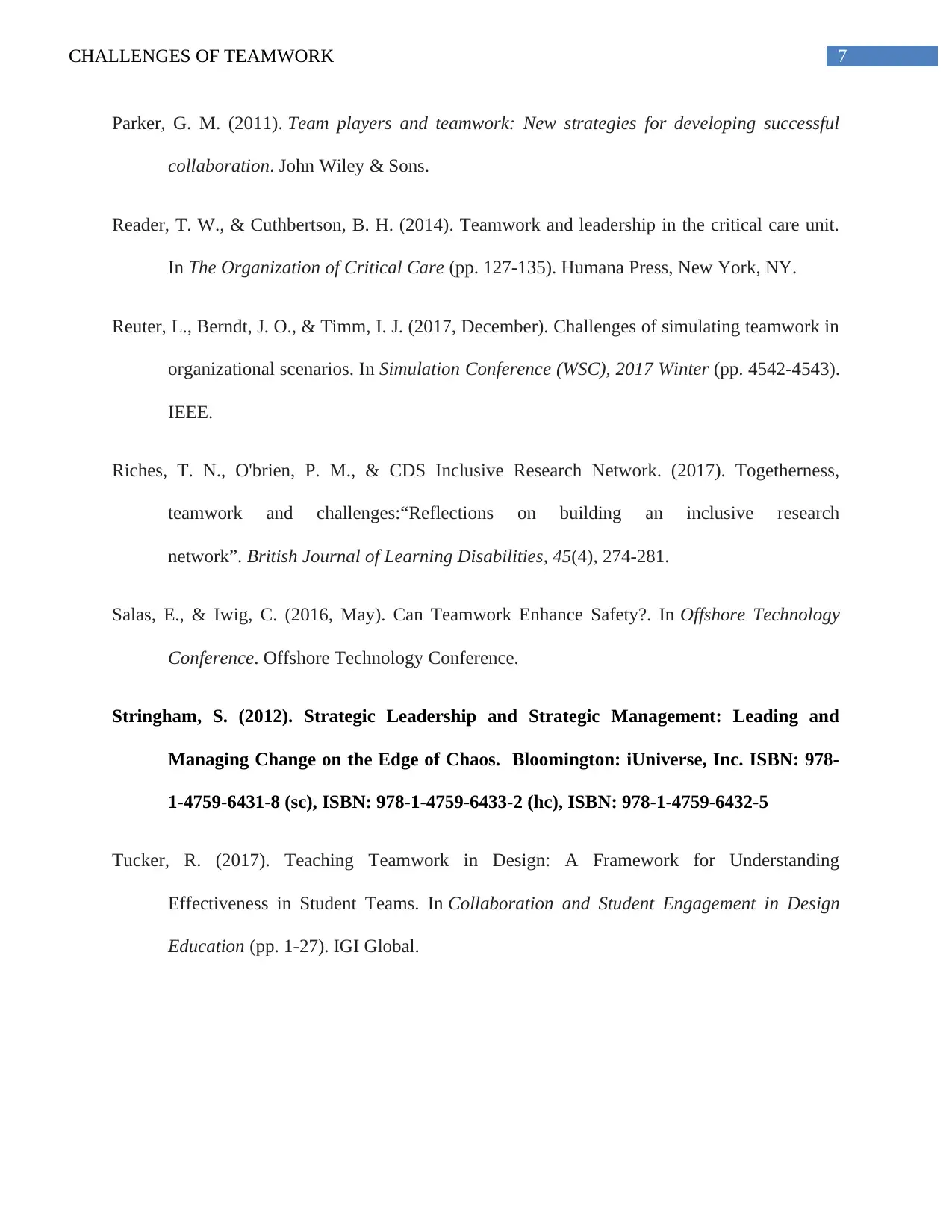
7CHALLENGES OF TEAMWORK
Parker, G. M. (2011). Team players and teamwork: New strategies for developing successful
collaboration. John Wiley & Sons.
Reader, T. W., & Cuthbertson, B. H. (2014). Teamwork and leadership in the critical care unit.
In The Organization of Critical Care (pp. 127-135). Humana Press, New York, NY.
Reuter, L., Berndt, J. O., & Timm, I. J. (2017, December). Challenges of simulating teamwork in
organizational scenarios. In Simulation Conference (WSC), 2017 Winter (pp. 4542-4543).
IEEE.
Riches, T. N., O'brien, P. M., & CDS Inclusive Research Network. (2017). Togetherness,
teamwork and challenges:“Reflections on building an inclusive research
network”. British Journal of Learning Disabilities, 45(4), 274-281.
Salas, E., & Iwig, C. (2016, May). Can Teamwork Enhance Safety?. In Offshore Technology
Conference. Offshore Technology Conference.
Stringham, S. (2012). Strategic Leadership and Strategic Management: Leading and
Managing Change on the Edge of Chaos. Bloomington: iUniverse, Inc. ISBN: 978-
1-4759-6431-8 (sc), ISBN: 978-1-4759-6433-2 (hc), ISBN: 978-1-4759-6432-5
Tucker, R. (2017). Teaching Teamwork in Design: A Framework for Understanding
Effectiveness in Student Teams. In Collaboration and Student Engagement in Design
Education (pp. 1-27). IGI Global.
Parker, G. M. (2011). Team players and teamwork: New strategies for developing successful
collaboration. John Wiley & Sons.
Reader, T. W., & Cuthbertson, B. H. (2014). Teamwork and leadership in the critical care unit.
In The Organization of Critical Care (pp. 127-135). Humana Press, New York, NY.
Reuter, L., Berndt, J. O., & Timm, I. J. (2017, December). Challenges of simulating teamwork in
organizational scenarios. In Simulation Conference (WSC), 2017 Winter (pp. 4542-4543).
IEEE.
Riches, T. N., O'brien, P. M., & CDS Inclusive Research Network. (2017). Togetherness,
teamwork and challenges:“Reflections on building an inclusive research
network”. British Journal of Learning Disabilities, 45(4), 274-281.
Salas, E., & Iwig, C. (2016, May). Can Teamwork Enhance Safety?. In Offshore Technology
Conference. Offshore Technology Conference.
Stringham, S. (2012). Strategic Leadership and Strategic Management: Leading and
Managing Change on the Edge of Chaos. Bloomington: iUniverse, Inc. ISBN: 978-
1-4759-6431-8 (sc), ISBN: 978-1-4759-6433-2 (hc), ISBN: 978-1-4759-6432-5
Tucker, R. (2017). Teaching Teamwork in Design: A Framework for Understanding
Effectiveness in Student Teams. In Collaboration and Student Engagement in Design
Education (pp. 1-27). IGI Global.
1 out of 8
Related Documents
Your All-in-One AI-Powered Toolkit for Academic Success.
+13062052269
info@desklib.com
Available 24*7 on WhatsApp / Email
![[object Object]](/_next/static/media/star-bottom.7253800d.svg)
Unlock your academic potential
Copyright © 2020–2025 A2Z Services. All Rights Reserved. Developed and managed by ZUCOL.




